After the mass use of plastic, some consumers are starting to turn back to glass – now also in the form of reusable bottles, such as the shatter-resistant glass water bottles developed by Walt Himelstein.
Glass, it seems, is making a bit of a comeback, also thanks to the development of a reusable glass bottle that is hard to break and will not shatter if broken.
In fact, the danger of broken glass has prompted many gyms, yoga studios and other places to ban glass bottles. But Walt Himelstein, the person who developed the Pure shatter-resistant bottle, is hoping to change those policies.
Reusable glass water bottles typically use a plastic sleeve for protection. The sleeves on most models have holes that allow the contents of a bottle to be seen but through which broken glass can escape. Himelstein’s bottles, on the other hand, are encased in a see-through coating which holds the bottle in place if it cracks.
He worked with glass coatings as an environmental chemist at General Physics Corporation in Maryland, and wondered if he could find something similar that would protect consumers from being cut when a reusable glass bottle broke.
“Hazardous materials were delivered in glass bottles with a material coated on the exterior,” said Himelstein, who lives in the Baltimore area. “If a coating could be developed for containers of hazardous materials, I thought why not for glass water bottles?”
He thought he had the hard part done after he invented the coating – until he tried to find a company to make the bottles – all very occupied with their normal high-production quantity manufacturing procedures.
Although he had wanted to make the entire product in the US, he ultimately went to China.
Almost two years after he started, he had a product he could market but the next obstacle was finding someone to sell them, and then investors.
Meeting up with Marc Heinke, president and chief executive of Precidio Design, a Canadian company whose primary business has long been making melamine tableware, was the solution.
Himelstein and Heinke are now working on plans to expand sales of the Pure bottle, also for lunchboxes, with different types of lids and for new colours and labels.
No one expects glass to replace plastic immediately, but, in a survey of more than 4,000 consumers this year by EcoFocus Worldwide, a research and consulting group, 37% said they were extremely or very concerned about the health and safety of plastics used in food and water packaging, compared to 33% in 2010.
EcoFocus also found that 59% of the consumers it surveyed used reusable water bottles always or often, up from 56% in 2010.
In a smaller survey of about 2,600 people, 42% said they had stopped drinking water from plastic bottles or were drinking it less often.




